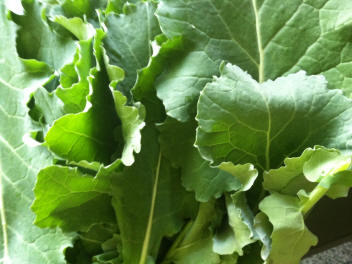(1/13) Brussels Sprout -Brassica oleracea is in the Germmifera Group. In case you were wondering – Yes Brussels is the original place of cultivation. Brussels is in Belgium Western Europe.
 It is a cultivar group of the wild cabbage. It has small leafy green heads which resemble miniature cabbages. It is a very important Winter vegetable. They are considered a cool weather crop. For this reason, it is best to plant 3-4 varieties to get them established
during the cool seasons – Spring or Fall. Frost does not harm them. In fact, they taste even sweeter after a frost.
It is a cultivar group of the wild cabbage. It has small leafy green heads which resemble miniature cabbages. It is a very important Winter vegetable. They are considered a cool weather crop. For this reason, it is best to plant 3-4 varieties to get them established
during the cool seasons – Spring or Fall. Frost does not harm them. In fact, they taste even sweeter after a frost.
If you sow in April, they will be ready for harvesting in September. However, your September crop picking can last as long as January or even up to March, because they do better in the colder months.
A single plant can yield up to 100 sprouts. Any surplus you may have can be frozen to use when severe winter weather makes getting out there to harvest difficult. When planting keep a good planting distance between plants. Plant 3-4 ft apart and tread in firmly if the soil is friable. Hoe between plants and water copiously in dry weather.
When the sprouts are 1in in diameter, gently remove from the stem taking several from each plant. This allows the other more room to develop. Remove dead leaves from the plant.
Watch out for mildew they leave a gray mold on the leaves. This can be controlled with monthly spraying.
Collard Greens scientifically known as Brassica oleracea - Acephala is another crop with dark edible leaves which are extremely tasty and are packed with vitamin E, beta-carotene (pro-vitamin A). The leaves are rich in calcium; Each 100g of leaves provides 46 calories (190 kilojoules of food energy and contains 4g of protein, 0.4g of fat, 7g of
carbohydrates. You are likely to receive at least 226mg per cup when the greens are cooked. Other vitamins are B1,B2, B9 and C which may be leached by cooking.
Only cook the dark green leaves. Discard wilted or yellowish leaves. Due to their tough cell structure, they do better cooked then when eaten raw.
It is said to counter heart disease and aging diseases like Alzheimer's. They are classified in the same cultivar group as kale and spring greens. The name collard is said to derive from the Anglo-Saxon coleworts or colewyrts. It can also be grown for its ornamental attraction in your garden.
It is very easy to grow and best to get established during the cool season. I grow this every year in our vegetable garden and it has been both an ornamental attraction and a tasty dish packed with healthy nutritional benefits.
I do hope you will be able to plant one or both of these crops this planting season. And if not, buying some from the green grocers will do just fine.
Read other articles on growing herbs or vegetables
Read other articles by Marann Jones